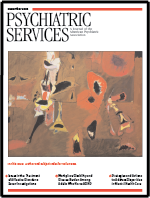In Reply: We too are grateful for the editorial decision to dedicate a section of the September issue of Psychiatric Services to reports of current efforts to reduce and eliminate the use of seclusion and restraint. We hope that publication of our study from the Pennsylvania state hospital system and other such studies will lead to further research on more positive strategies to support a person in crisis.
The safe and minimal use of seclusion and restraint, as Dr. Herzog indicates, should now be a requirement for all psychiatric health care providers. However, too many people continue to be injured from the use of these restrictive measures. In our Pennsylvania state hospital system, which trains staff in the most current strategies, we discovered that one in five applications of mechanical restraint resulted in an injury to the patient or staff member involved. These are high-risk activities that have no therapeutic value in supporting a person with serious mental illness, and, as we have discovered, they do far more harm than any short-term gain that their use may provide. Psychiatric treatment providers need to find more positive ways to support people who are in crisis.
Ten years ago most people in our hospital system accepted the use of seclusion and restraint and regarded these practices as clinical interventions for managing a person in crisis or as proactive interventions in anticipation of a crisis. During this period the "dogma" of the nonrestraint approach was polarizing our hospital community. However, the hospital system's leadership—physicians, nurses, direct care workers, and program staff—who supported a less traumatizing approach prevailed and drove the culture change that has resulted in a safer hospital system.
Most people served in our hospital system are first cared for within a short-stay acute care setting. People who were admitted to our civil hospitals were unable to be stabilized within such a setting. Moreover, in our three forensic units at Mayview, Norristown, and Warren state hospitals, where direct acute admissions continue to occur, reduction in the use of seclusion and mechanical restraint has been equally dramatic. Since January 2005 the three forensic centers have had an average daily census of 190 and have provided 5,700 days of care each month. During this period mechanical restraint has been used only 34 times and seclusion has been used 22 times. Several forensic units have not needed to use these measures at all in the past nine months.
Early next year the hospital system will discontinue the use of the mechanical restraint in all civil and forensic units. The traumatizing effects of these measures, for both patients and staff, have eclipsed any short-term safety benefit they may provide and are inconsistent with the recovery approach that we have adopted.



